

Feedback Loop

Set Up









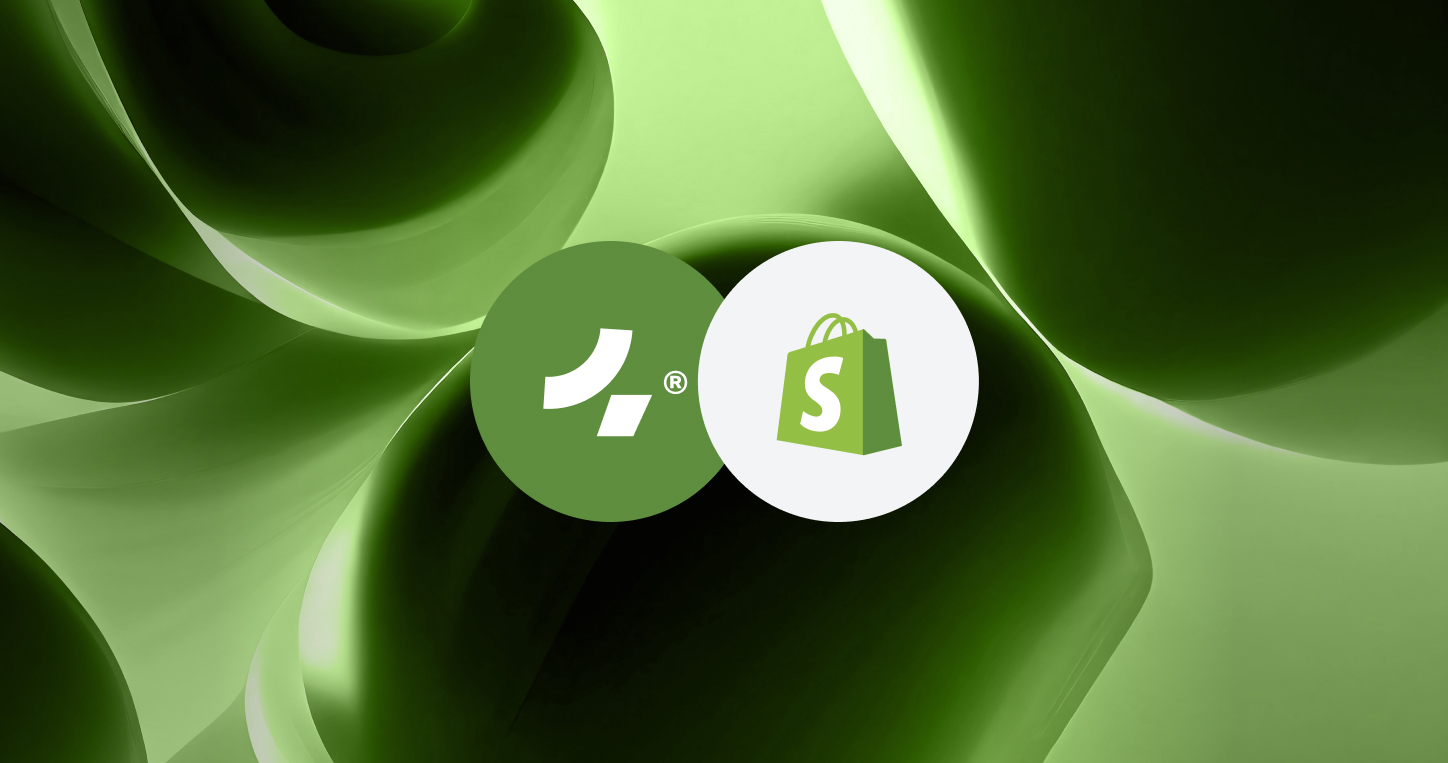
Trying to decide between Shopify and Shopify Plus? Both are part of the same e-commerce ecosystem, but they serve different needs. In this guide, we’ll break down Shopify vs Shopify Plus to show what you’re paying for, when to upgrade, and how to future-proof your online store. Let’s find out which tier suits your business best.
Shopify’s standard plans (Basic, Shopify, Advanced) and Shopify Plus are built on the same platform, but they target different stages of business growth. Shopify (the core plans) is ideal for startups and mid-sized brands, offering all the essential features to launch and run an online store. Shopify Plus, on the other hand, is the enterprise upgrade – designed for advanced needs like high-volume sales, complex operations, and large teams.
The core difference comes down to scale and flexibility. With Shopify Plus, you get enterprise-level capabilities: the ability to fully customize your checkout, more robust automation tools, priority infrastructure, and dedicated support. For example, Plus merchants can edit the checkout code and use exclusive tools like Shopify Scripts and Launchpad (for flash sales scheduling), which standard plan users can’t . Plus also includes features for B2B/wholesale, multi-currency and cross-border commerce, and unlimited staff accounts – things beyond the reach of regular plans. In short, Shopify Plus offers advanced features specifically for large or fast-growing brands, whereas standard Shopify covers the basics for small to medium businesses .
A good rule of thumb: Shopify Plus is typically meant for brands doing around £1M or more in annual GMV (gross merchandise volume) – essentially those who have “graduated” from the standard plans and need more power . If you’re a founder processing a few thousand pounds a month, the regular Shopify plans will likely serve you well. But if you’re scaling fast (say, hitting seven-figure revenues) and finding the normal Shopify limits holding you back, it might be time to consider Plus.
Before we dive into specific features, remember that both Shopify and Shopify Plus share the same DNA. You’ll get a reliable, secure online store with either. The question is whether the extra perks of Plus justify the extra cost for you. Let’s compare those perks side by side.
To see how Shopify vs Shopify Plus stack up, let’s compare key features and limits of the standard Shopify plans versus Shopify Plus. This will highlight what you get by upgrading:
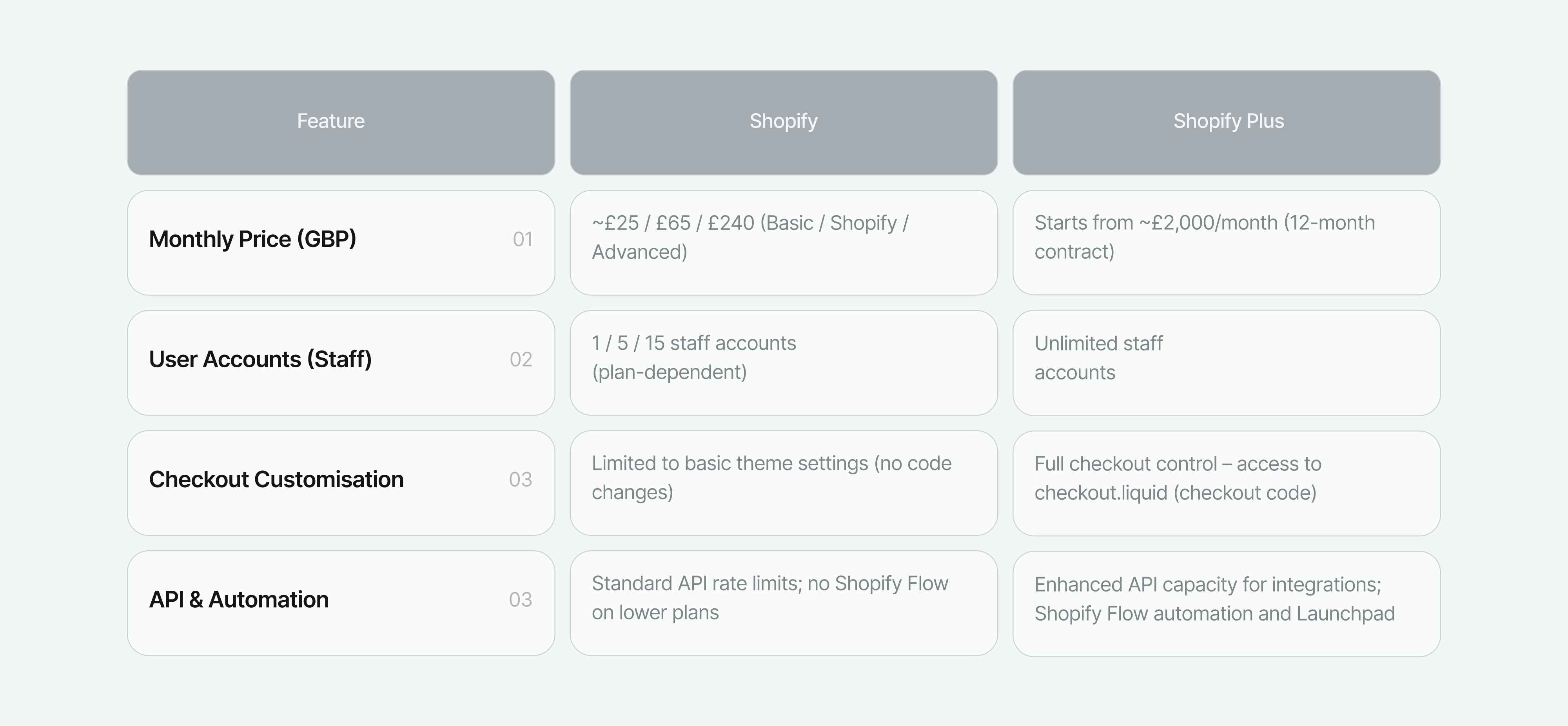
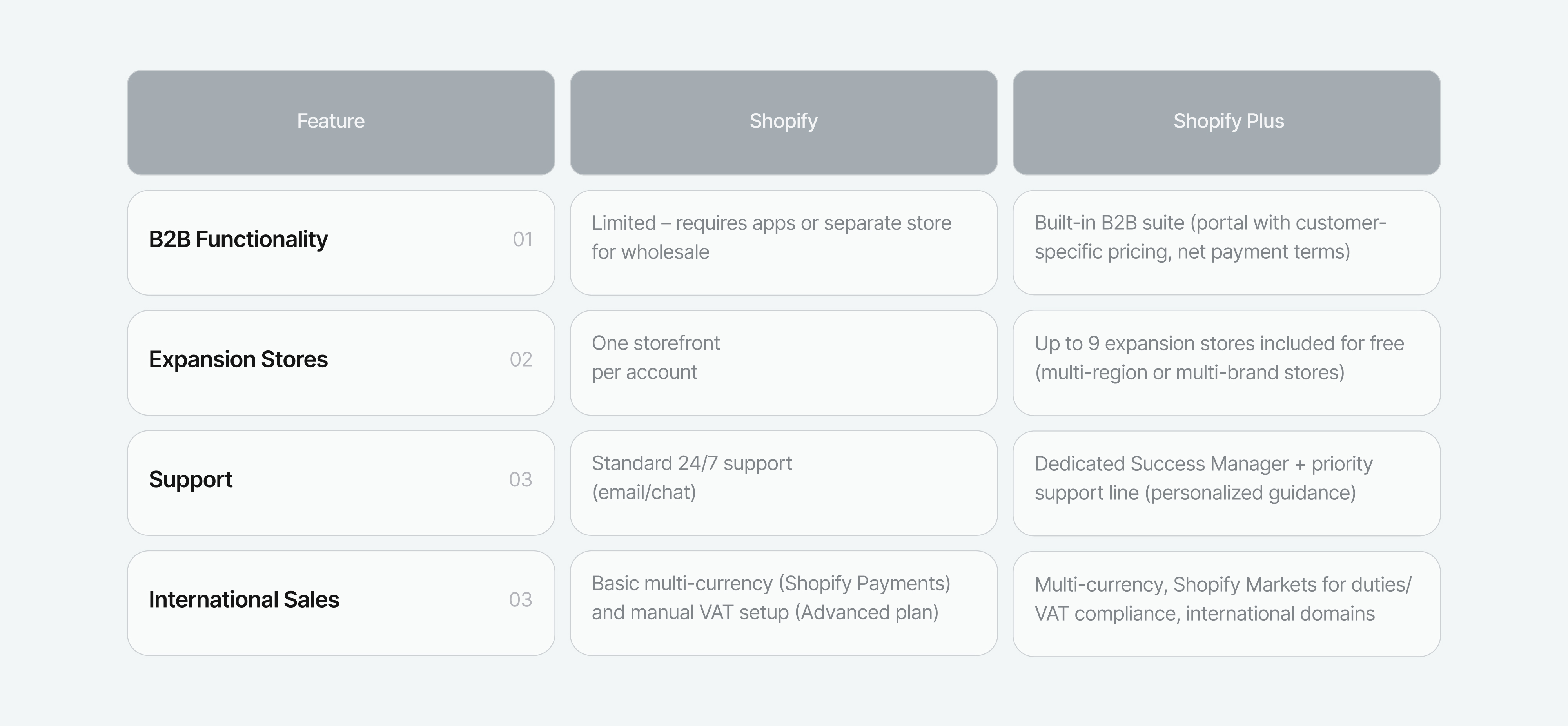
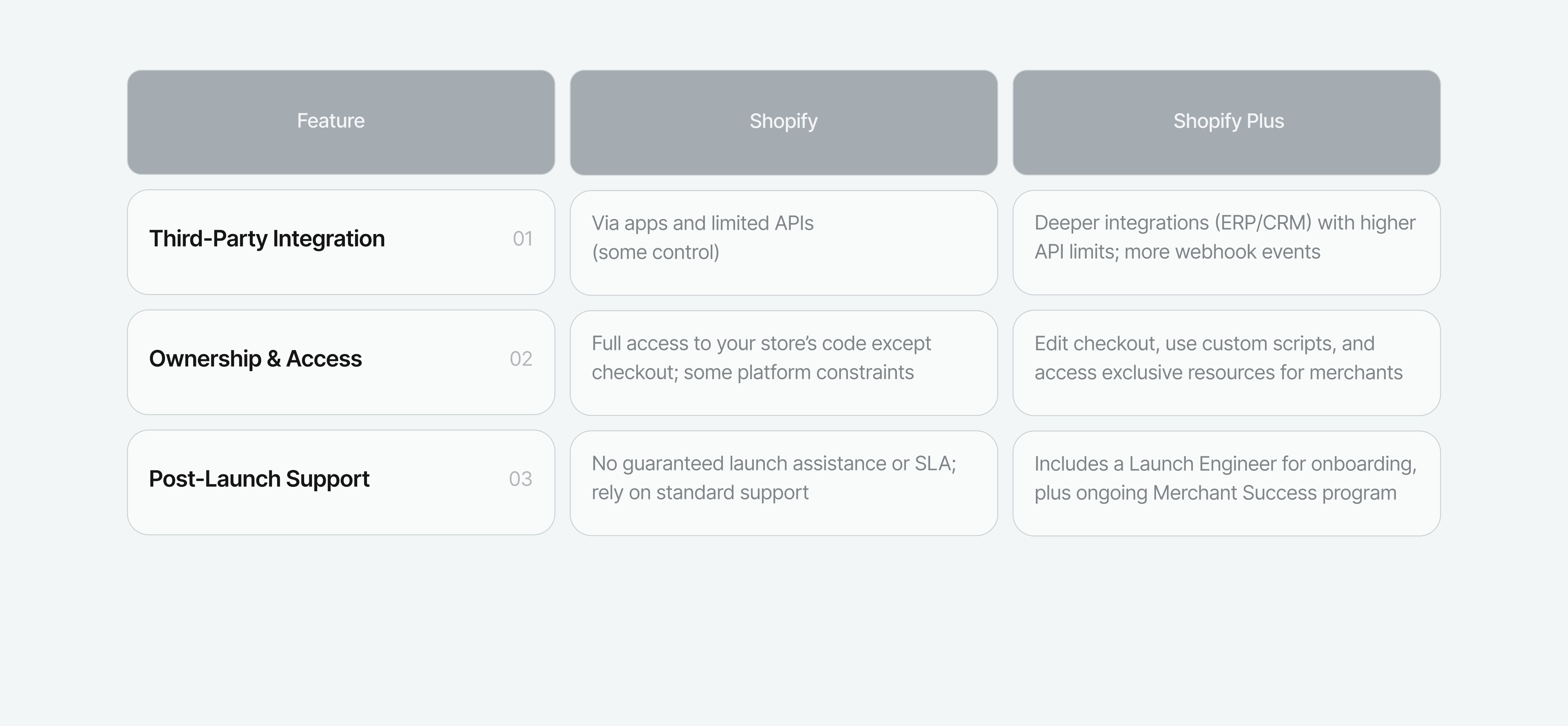
Note: Shopify is deprecating the older checkout.liquid method in favor of Checkout Extensibility (a new app-based approach), but this advanced checkout customization remains a Plus-exclusive capability. Standard plans cannot inject custom code into the checkout pages.
As the table shows, Shopify Plus unlocks a suite of features aimed at larger, more complex operations – from unlimited staff logins to multi-store management and built-in wholesale tools. Regular Shopify plans are feature-rich for a typical online store, but there are clear limits (for instance, no ability to deeply customize checkout, and a cap on how many staff/admin accounts you can have ). Next, we’ll discuss how to decide which tier fits your business.
Not every business needs the bells and whistles of Shopify Plus. In fact, the majority of growing brands do great on the standard Shopify plans. You should likely stick with Basic/Shopify/Advanced (standard Shopify) if:
In short, standard Shopify is a solid choice for most emerging eCommerce businesses. It’s cost-effective and simpler to manage. If you’re not bumping up against specific limitations, there’s no rush to upgrade. Instead, invest your energy in marketing, CRO (conversion rate optimization), and product improvement.
💡 Pro tip: Focus on nailing your customer experience and conversion funnel on the standard Shopify plan before considering Plus. Upgrading platforms won’t fix a broken funnel or lack of demand. Max out what the core plans offer (and maybe save money using a few apps) until you truly need more. Tech won’t magically create sales – a great product and website will.
So, when do successful brands make the leap to Shopify Plus? The answer: when Shopify starts becoming a bottleneck to growth or operations. Here are common scenarios where upgrading to Plus is justified:
“If you’re spending £5k/month on apps to compensate for Shopify’s limits, Shopify Plus might actually save you money.” In other words, if you find yourself bolting on dozens of apps (and their fees are stacking up) just to get functionality that comes native with Plus, then the math may work out in favor of upgrading. Instead of an “app Frankenstore,” Plus gives you built-in solutions under one roof.
🚩 Red flag: Don’t upgrade to Plus just for the prestige or because someone said “enterprise is better.” Upgrading without a clear ROI or need is a mistake. Plus is a fantastic platform if you will use its features, but it’s not a status symbol. Make sure you have concrete pain points or opportunities (like those above) that Plus addresses. Upgrading “just because” (or to say you’re on the biggest plan) can be an expensive vanity move.
Before you jump into a Shopify Plus contract, do a cost–benefit analysis. Shopify Plus starts around £1,500–£2,000 per month (≈$2,000+), which means you’re investing ~£18k–£24k a year at minimum. That cost needs to be justified by the benefits to your business.
Here are some factors to weigh:
At the end of the day, Plus is an investment in scalability and future-proofing. If your store is trending up, the enterprise-grade stability and features can prevent needing a costly re-platform later. It’s often more seamless to upgrade within the Shopify ecosystem (to Plus) than to switch to a whole new platform when you outgrow the core plans.
💡 Pro tip: Don’t evaluate the Plus fee in isolation. Look at the bigger picture metrics – customer lifetime value, conversion rate, operational savings, customer acquisition cost, etc. For example, if checkout customization on Plus leads to a higher LTV or lower CAC because customers have a better experience, that’s a long-term gain. Similarly, if Plus’s lower transaction fees or included POS Pro licenses save you money as you scale, factor that in. It’s not just about top-line revenue – consider profit and growth efficiency.
(Fun analogy: Upgrading to Shopify Plus is like moving from a reliable sedan to a high-performance sports car. It’s pricier and you’ll pay more for gas, but you get superior performance and capacity. If you’re just driving to the local shop, the sedan suffices. But if you’re entering a race or have a long road ahead on the highway, the sports car starts to make sense.)
Still wondering what Shopify Plus can tangibly do for a growing business? Let’s take a quick look at a real brand that made the jump. Dan John is an Italian menswear retailer that engaged Fourmeta to revamp their e-commerce presence. We migrated Dan John from a standard setup to a headless Shopify Plus store (a custom front-end with Shopify’s back-end) for greater performance and flexibility. The results were impressive:
By leveraging Shopify Plus features, we implemented a lightning-fast, mobile-optimized site with a custom checkout and even a “Look Builder” outfit tool for personalized shopping. This tailored user experience, combined with the robust infrastructure of Plus, led to a significant uptick in online sales and engagement. “Our customers love it, our conversion rates are high… We’ve built a store that won’t need renovations for a very long time,” said Dan John’s Marketing Director after the launch, highlighting the long-term value .
Want the full story? Check out our Dan John case study to see how a fashion brand scaled with Shopify Plus and headless commerce (including a 21% conversion uplift and industry awards).
Need help choosing the right agency to implement Shopify or Shopify Plus? Here’s how to find a reliable digital partner and avoid costly mistakes.
(This is just one example – Fourmeta’s team has experience with numerous brands on both standard Shopify and Shopify Plus. The key takeaway is that when used correctly, Plus can drive real growth, but it’s most impactful for businesses that truly need its advanced features.)
Deciding between Shopify vs Shopify Plus ultimately comes down to your unique business needs and growth stage. To recap: Shopify’s core plans are a cost-effective, capable choice for most small and mid-sized stores, while Shopify Plus is a heavier-duty solution for those with complex requirements or rapid scale. The upgrade is worth it when it aligns with a clear ROI – whether through higher sales, operational efficiency, or unlocking new markets (B2B or international). But if your current setup isn’t holding you back, you’re likely fine where you are.
Remember, your business model, team capacity, and growth trajectory should guide the decision. A lean startup with a tight budget will extract more value from optimizing marketing and product-market fit on a standard plan. A bustling brand with multi-country operations and six-figure monthly sales might outgrow the standard plans and benefit from Plus’s firepower.
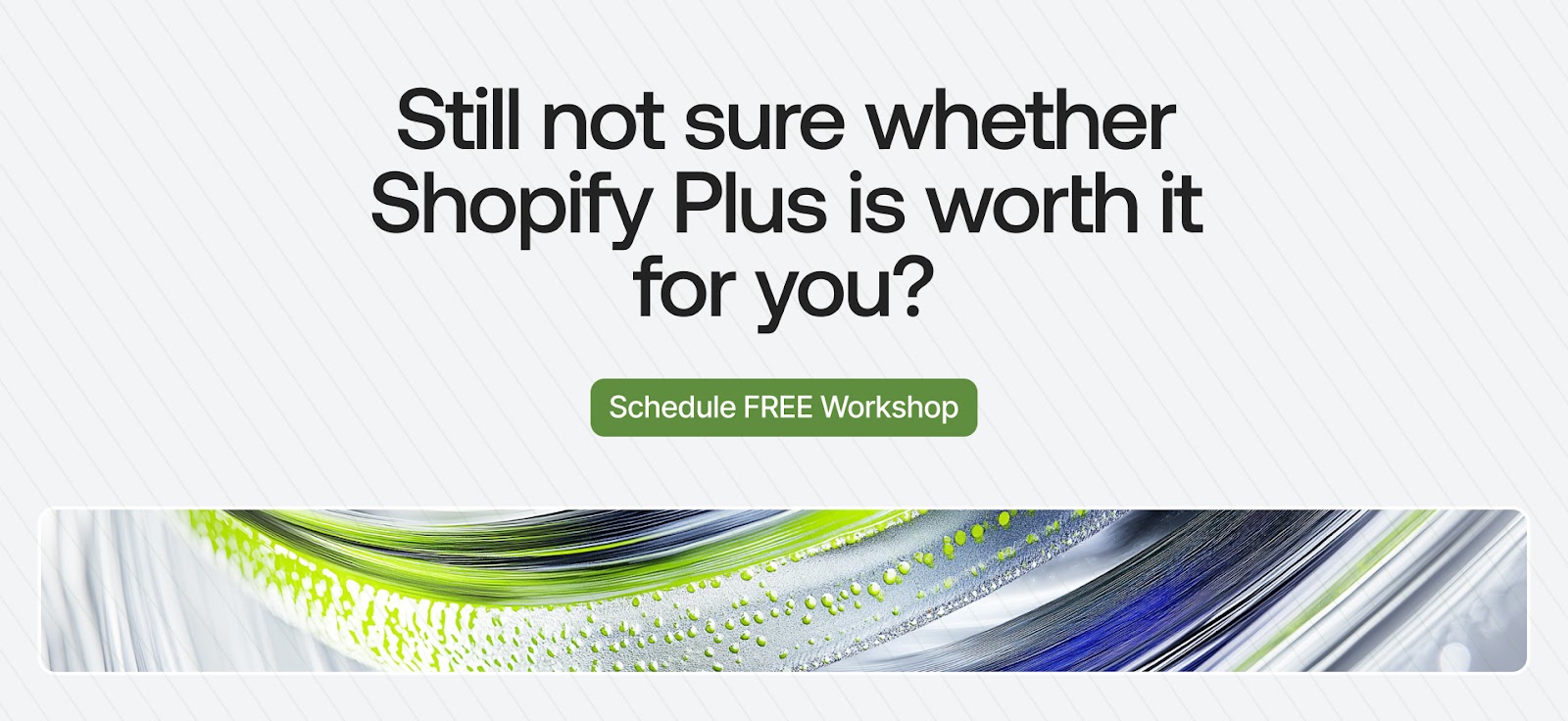
Still on the fence? It’s completely normal to be unsure – this is a big decision. That’s where we come in to help. Book a no-obligation Shopify audit with Fourmeta. Our experts will evaluate your store (performance, funnel, tech stack) and give you an honest recommendation on whether Shopify Plus is worth it for you – with no upsell and no strings attached. We’ve guided many merchants through this choice, and we’ll make sure you get the platform that fits your business, not the other way around.
Get in touch for a free Shopify/Plus audit – and let’s future-proof your e-commerce growth, together.
